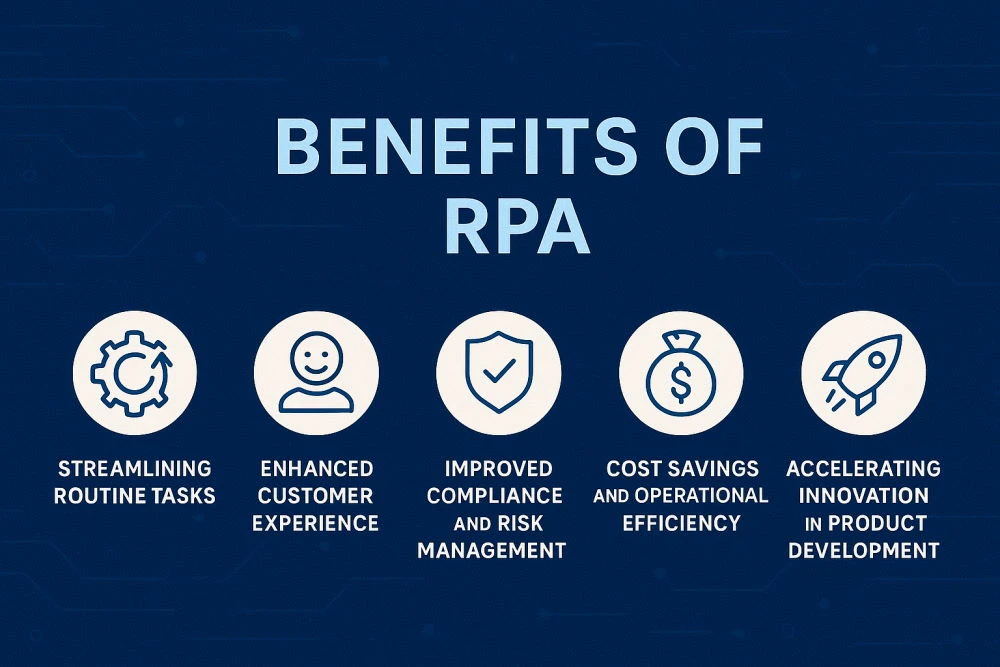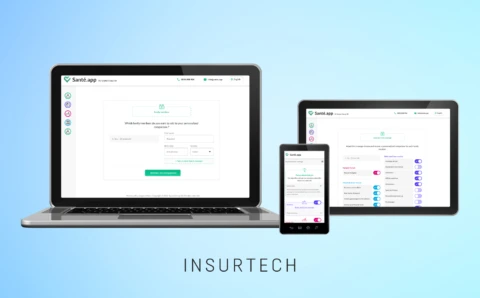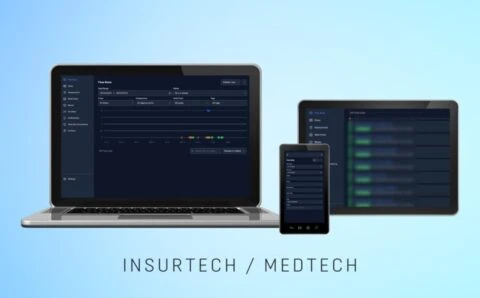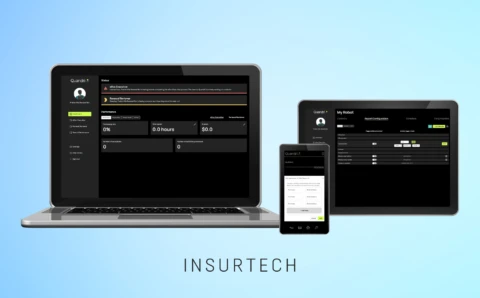
Insurance companies striving to obtain a competitive advantage should focus on efficient client service and increasing satisfaction rates. Businesses that prioritize customer experience increase their sales by up to 7%, as HubSpot states. A prevalent number of customers, surpassing 80%, have stated that receiving value during a service increases their likelihood of repurchasing, even when having the option to switch to a competitor. To elevate the client experience in insurance, it’s essential to prioritize efficient and timely services, a personalized approach, and thorough policyholder assistance. In terms of these requirements, the integration of automated solutions becomes inalienable for insurance vendors.
This is why insurance companies adopt Robotic Process Automation (RPA) software to boost their workflow, streamline costs, and provide a top-tier customer experience. Thus, according to AlliedMarketResearch insights, the RPA in insurance is projected to grow to $1.2 billion by 2031 at a CAGR of 28.3%, delivering a vast array of benefits, such as more reliable performance, operational costs decrease, improved processing accuracy, guaranteed regulatory compliance, and 24/7 operation.
In this article, you’ll discover the potential and benefits of RPA in insurance, covering which role this technology plays in the stated sector. Let’s start examining the way RPA services stand as a core solution in optimizing insurance operations.
Table of Contents:
Streamlining Routine Tasks
RPA is an excellent instrument for streamlining the tiring data entry and validation processes within the insurance sector. These tasks used to be time-consuming and prone to manual mistakes while inputting the information. RPA integration services for Insurance help agencies achieve automated accuracy and systematic precision of such time-consuming procedures, introducing smooth and error-free data entry. Therefore, you get the opportunity to skyrocket the entire processing effectiveness, allocating human resources for more vital activities, necessitating manual expertise.
Efficient claims processing, integral in the insurance domain, can’t be carried out without precision and timeliness. RPA optimizes this flow by assisting claims processing through its capacity to analyze and validate details faster. Automation guarantees that claims are evaluated and settled efficiently, facilitating top-tier customer satisfaction and further retention. The streamlined workflow provided by RPA eliminates setbacks in operations, so insurers can meet customer expectations while maintaining performance accuracy and excellence.
The risk of manual errors in insurance operations may have profound consequences, and to avoid this situation, RPA acts as a safeguard against such errors by executing tasks with precision and consistency. Automation both liquidates mistakes and enhances the overall accuracy of processes, contributing to a more reliable and trustworthy insurance ecosystem. This allows you to build a strong business strategy, make correct decisions, and build more confidence among stakeholders, policyholders, regulators, and industry partners.
Worried About the Price Tag of RPA??
Don’t let cost concerns hold you back. Find out how affordable and accessible RPA solutions can be.
Enhanced Customer Experience
RPA benefits for insurance operations ensure a competitive edge on the market, raising customer interactions. The technology’s power to robotize day-to-day and complex tasks makes response times almost instant, providing that customer queries, claims, and requests are processed more efficiently despite the current time. Automation cuts down manual intervention, minimizing the possibility of failures and delays. With swift and accurate processing, you can enhance your client support service responsiveness, obtaining more trust and satisfaction among policyholders. Consequently, this conditions a positive reputation of you as a credible insurance provider and promotes customer loyalty.
For instance, one of the outstanding advantages of RPA for insurance is its capacity to allow personalized interactions. Based on the vast sets of customer data research, RPA algorithms can determine patterns, preferences, and behaviors so your insurance business is able to tailor communication and services to individual policyholders. Insurers can ensure individual policy recommendations or targeted promotional offers, using RPA to turn ordinary interactions into personalized, meaningful engagements. This customization in every interaction elevates the customer experience and consolidates the connection between insurers and their clients.
The important RPA use cases in insurance lie in the ability to monitor and update the policy details in real time, so customers are constantly provided with access to the most recent data at their disposal. This may imply any data, like tracking the status of a claim or reviewing policy modifications; with RPA, the information flow will be optimized. The live visibility brings in higher transparency, so customers get instant insights into their coverage and minimize uncertainties. Such client centricity and clarity are the foundation for building trust and confidence, as policyholders feel more informed and connected to their insurance providers.
Improved Compliance and Risk Management
 Adherence to industry-specific standards is a must for such a data-sensitive niche as insurance, with the RPA providing a reliable solution to navigate the entanglement of regulations. The regulatory environment is constantly modifying, demanding insurance companies to accurately track and comply with a myriad of rules and policies. RPA offers robotization of regulatory changes’ monitoring, as well as seamless adaptation flow to stay compliant. With the integration of RPA into routine compliance tasks, insurers can significantly cut down the risk of overlooking critical updates, sticking to a flexible and smooth approach to regulatory adherence.
Adherence to industry-specific standards is a must for such a data-sensitive niche as insurance, with the RPA providing a reliable solution to navigate the entanglement of regulations. The regulatory environment is constantly modifying, demanding insurance companies to accurately track and comply with a myriad of rules and policies. RPA offers robotization of regulatory changes’ monitoring, as well as seamless adaptation flow to stay compliant. With the integration of RPA into routine compliance tasks, insurers can significantly cut down the risk of overlooking critical updates, sticking to a flexible and smooth approach to regulatory adherence.
Manual failures in data inputting and inefficient processing may cause such heavy negative impacts on your insurance business as non-adherence with regulations, incompliant performance, penalties, and of course, severe reputation damage. This is why the invaluable benefits of Robotic Process Automation for insurance allow insurance companies to reduce this risk by fulfilling tasks with the highest accuracy and consistency. The delegation of repetitive, rule-based processes to such a digital assistant minimizes the possibility of potential regulatory violations. You can thus elevate the accuracy of your operations and create a solid ecosystem for maintaining compliance.
Such advantages of Robotic Process Automation for insurance, such as transparency and accountability, can make you stand out in the insurance industry, especially concerning compliance and risk management. The adoption of RPA takes over the complicated system of audit trails, comprehensively documenting every stage of automated flows. These in-depth logs serve as a transparent record, making insurers take more precise decisions and actions. When it comes to the audit or compliance review, these across-the-board audit trails equip insurers with the evidence to showcase adherence to legislative acts, introducing accurate accountability into the organization.
Cost Savings and Operational Efficiency
Robotic Process Automation benefits for insurance directly impact the overall operational effectiveness and outgoings as well. One of the most immediate and tangible results of RPA integration into insurance processes is the substantial reduction in operational costs. RPA is suitable for delegating frequent and algorithmic processes that are often made with high human intervention. These routine activities can be delegated to software robots, allowing insurers to decrease the necessity for manual labor. This converts into cost savings associated with payrolls, training, and human-made failures. Furthermore, the capacity and accuracy of RPA guarantee faster task completion, with less time and resources required for various operational functions. This makes RPA integration cost a single-time investment with long-term financial benefits.
RPA use cases cover accelerating internal and external insurance flows and facilitating higher productivity of the business. With more human resources freed up, you can direct more attention to more strategic activities that require critical thinking and decision-making. The scalability of RPA enables you to adapt smoothly to varying workloads. In the event of struggling with an unexpected surge in policy processing or an inflow of claims, you can adapt your RPA systems to perfectly and accurately cope with increased volumes, serving clients with the remaining top-tier insurance journeys.
By taking over routine tasks, RPA enables insurance professionals to redirect their specialization and valuable skills toward higher-value activities. The optimization of workforce resources is a strategic move that elevates customer service, as well as the work satisfaction of your team. With RPA taking charge of daily responsibilities and procedures, manual powers can focus on tasks that require creativity and more nuanced decision-making, enhancing the quality of service provided to policyholders.
Our collaboration with Quandri on the Robot Factory project exemplifies the benefits of Robotic Process Automation (RPA) in insurance. We developed bots that automated labor-intensive tasks such as e-document management and policy renewal workflows. This reduced manual errors, cut operational costs, and freed up brokers’ time for more strategic activities. One client reported reclaiming up to 120 hours per month, while another achieved a 90% acceleration in workflows. These success stories illustrate how RPA can modernize insurance processes and drive operational excellence.
Worried About the Price Tag of RPA??
Harness the power of RPA to streamline processes, enhance customer experiences, and drive innovation.
Accelerating Innovation in Product Development
The introduction of product development innovations is on the list of Robotic Process Automation benefits for insurance, bringing insurers into an environment of elaborated creativity and efficiency.
RPA can handle tedious tasks such as data entry, data extraction, document processing, and analyzing large volumes of data much faster than manual effort. The automation frees up valuable human resources to concentrate on more innovative and complex aspects of product development.
Data is a goldmine for every insurance business. RPA’s pros enable the seamless integration and investigation of huge datasets, indicating vital insights for market research and product enhancement. You can delegate data-related tasks with RPA and make informed decisions based on the extracted details. The data-driven approach expedites the determination of market trends and gives you the opportunity to refine existing business fields and products, aligning with real-time feedback and following continuous improvement.
The insurance market is dynamic, transformed by economic alterterings, regulatory modifications, and changing customer demands. RPA provides insurers with the capacity to respond to these evolvements faster. Automated and optimized processes ensure that adjustments to products, pricing models, and underwriting criteria can be implemented rapidly, allowing insurers to stay ahead in the crowded industry. This adaptability is crucial in maintaining competitiveness and ensuring that insurance offerings remain sought-after within the varying demands of the market.

Santé.app
Santé.app helps users easily select health insurance by automating comparisons, preferences through simple surveys and tailored recommendations.

AI Platform
Our AI-Assisted platform streamlines European medical institutions’ administrative tasks, improving patient service quality and operational productivity.

Robot Factory
Robot Factory empowers insurance brokers with automation, providing a platform for efficient document management and up to 90% faster workflows.
The implementation of RPA allows insurers to employ and direct the technology’s power into a broad spectrum of processes. With automation, insurance companies streamline processes, make maximum use of data, eliminate inaccuracies, and respond smoothly to market dynamics and policyholders’ requirements as the industry undergoes a shift toward innovation and efficiency.
Adopt the benefits of RPA for your insurance business and experience the performance capacity that will take you to success. Employ the power of RPA, addressing your business requirements and seamlessly integrating into your operations. The PLANEKS experts are at your disposal, contact us to consult on the RPA benefits and peculiarities within the implementation into your business. Introduce innovation, enhance efficiency, and streamline your approach to insurance services delivery. Let’s take the first step towards a more innovative and efficient insurance future together.

